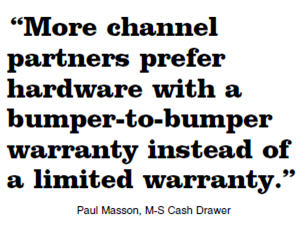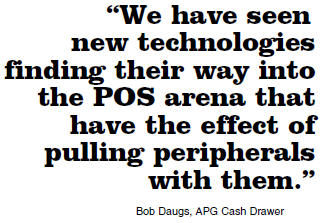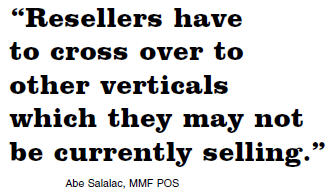New Technologies Drive Sales Of POS Peripherals
By Brian Albright, Business Solutions magazine.
Cloud services and mobile POS are just two reasons why opportunities abound for POS peripheral sales this year.

Both the economy and the development of new point of sale (POS) technologies are impacting the POS peripherals space for resellers. In order to succeed, VARs will have to adjust their peripherals offerings so they are positioned to capitalize on emerging opportunities.
First, the continued emphasis on price by customers has affected how VARs — and their clients — select POS peripherals, especially when it comes to warranties. Familiarize yourself with each manufacturer’s warranty coverage, and make sure your clients understand what will happen when there is an equipment problem. “More channel partners prefer hardware with a bumperto- bumper warranty instead of a limited warranty,” says Paul Masson, president of M-S Cash Drawer. “They also prefer to select hardware with spare-in-the-air warranties instead of standard depot warranties. This allows channel partners to charge their customers for traditional annual maintenance contracts (AMCs) while eliminating the need to have a full-time technician on staff. When the customer needs a peripheral repaired, the manufacturer’s bumper-to-bumper or spare-in-the air warranty kicks in.”
Overall, the vendors interviewed for this story said that demand for peripherals has remained healthy, spurred, in part, by adoption of new technologies. For instance, new demand has been created by the infiltration of mobile POS solutions that use tablet computers and other types of hardware (and thus need new types of peripherals), as well as the advent of hosted or cloud-based POS applications. “We have seen new technologies finding their way into the POS arena that have the effect of pulling peripherals with them,” says Bob Daugs, business development manager at APG Cash Drawer. “Mobility is one such area that has been a strong growth area in POS. Of course, some customers still want receipts or to even pay with cash. Both scenarios require printers and cash drawers to be available in the store.”

Know Your POS Hardware
There are a few POS manufacturing changes that will impact peripheral selection. Some manufacturers, for instance, are eliminating parallel and secondary VGA ports from their terminals, but end users often want to add a secondary LCD for digital advertising. Other manufacturers are adding new USB ports to their terminals. “Channel partners need to make sure the POS system they recommend is future proofed for VGA/HDMI port availability,” Masson says. “Channel partners also can benefit from selecting POS terminals with field-installable peripherals.

This will allow end users to simply replace a credit card reader as encryption catches on rather than having to replace the entire POS terminal.”
Increasing POS Opportunities
For VARs to continue to boost their POS and peripherals business, the key is to broaden your horizons and applications. “Resellers have to cross over to other verticals which they may not be currently selling,” says Abe Salalac, director of sales and marketing at MMF POS. For instance, security monitoring and digital signage are POS-related applications that have great growth potential. Furthermore, investigate the possibility of offering cloudbased solutions if you don’t already. While it takes careful planning to make the transition from premise-based to hosted applications, these cloud offerings can provide month-to-month income on a recurring basis.
Some peripherals don’t require you to sell an entirely new type of system (e.g. digital signage, video security) — and they can help add incremental revenue from existing customers. “The channel can help its customers reduce power-related hardware failures by implementing power protection devices with every system deployed,” Masson explains. Asset management is another example of how VARs can generate follow-on sales with existing customers. “These packages allow the user to track the usage of each piece of equipment they have deployed,” Daugs says. “Service schedules can be set up according to actual usage versus a calendar-based schedule. Underutilized assets can be swapped into locations where overused machines are running, thus extending the overall life of the equipment.”
Mobile POS Drives Peripheral Sales
Mobile POS is another growth area that will spur sales of new peripherals. “A mobile POS solution allows the sales associate to engage the customer anywhere in the store, assist them with their selection, and check them out at the same time,” Daugs explains. “Having a mobile device also allows the associate to take the customer to the company’s website to answer questions or look for an item that isn’t available on the retail floor. Focusing on the customer in this way brings value to their experience, thus growing sales and repeat business.”
The downside to mobility is that standard POS terminal sales will be affected. Offering the right balance of solutions to customers will be critical to maintain sales. “With the emergence of mobility, resellers have to find the right products to complement fixed PC and POS systems and address the need for mobility,” Salalac says. “Furthermore, future system upgradeability is derivative.”

PCI compliance, while it doesn’t address most peripherals specifically, will also indirectly spur new peripherals sales, provided that VARs stay on top of their customers’ upgrade needs. “The evolution of PCI compliance is accelerating adoption of encrypted payment processing hardware,” Masson says. “As an added security measure, government agencies are also beginning to require Windows 7 or POSReady 7 operating systems, which enable hard drives to be encrypted. Smaller end users are asking for credit card readers and mobile phone readers to be encrypted to improve security. As PCI compliance continues to evolve, some customers may be forced to replace systems or peripherals sooner than expected to meet the latest mandates.”
